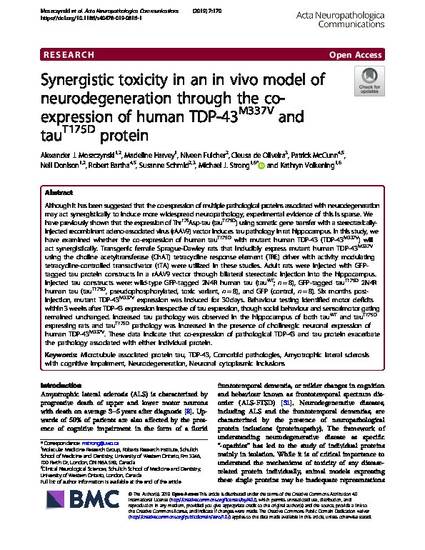
Although it has been suggested that the co-expression of multiple pathological proteins associated with neurodegeneration may act synergistically to induce more widespread neuropathology, experimental evidence of this is sparse. We have previously shown that the expression of Thr175Asp-tau (tauT175D) using somatic gene transfer with a stereotaxically-injected recombinant adeno-associated virus (rAAV9) vector induces tau pathology in rat hippocampus. In this study, we have examined whether the co-expression of human tauT175D with mutant human TDP-43 (TDP-43M337V) will act synergistically. Transgenic female Sprague-Dawley rats that inducibly express mutant human TDP-43M337V using the choline acetyltransferase (ChAT) tetracycline response element (TRE) driver with activity modulating tetracycline-controlled transactivator (tTA) were utilized in these studies. Adult rats were injected with GFP-tagged tau protein constructs in a rAAV9 vector through bilateral stereotaxic injection into the hippocampus. Injected tau constructs were: wild-type GFP-tagged 2N4R human tau (tauWT; n = 8), GFP-tagged tauT175D 2N4R human tau (tauT175D, pseudophosphorylated, toxic variant, n = 8), and GFP (control, n = 8). Six months post-injection, mutant TDP-43M337V expression was induced for 30 days. Behaviour testing identified motor deficits within 3 weeks after TDP-43 expression irrespective of tau expression, though social behaviour and sensorimotor gating remained unchanged. Increased tau pathology was observed in the hippocampus of both tauWT and tauT175D expressing rats and tauT175D pathology was increased in the presence of cholinergic neuronal expression of human TDP-43M337V. These data indicate that co-expression of pathological TDP-43 and tau protein exacerbate the pathology associated with either individual protein.
Moszczynski, A.J., Harvey, M., Fulcher, N. et al. Synergistic toxicity in an in vivo model of neurodegeneration through the co-expression of human TDP-43M337V and tauT175D protein. acta neuropathol commun 7, 170 (2019). https://doi.org/10.1186/s40478-019-0816-1
